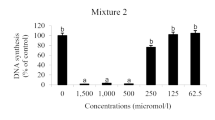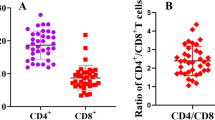Abstract
The synthetic glucocorticoid, dexamethasone, has been used by investigators studying bovine immune mechanisms to either exacerbate infectious processes or simulate stress-induced steroid-influenced immunosuppression. Considerable differences exist in the literature concerning the effect of dexamethasone on the bovine immune response.
The purpose of our study was to clarify the reported effects of dexamethasone on bovine T-lymphocyte function. Therefore, we designed experiments to evaluate cellular and humoral aspects of the bovine immune response under the influence of dexamethasone. The experiments took into consideration the pharmacokinetics of dexamethasone and optimal and suboptimal doses of selected mitogens. The data suggest little variation in hematological parameters that occurred with the administration of dexamethasone. Leukocyte counts were slightly elevated at two observations, and this was believed to be the result of an increase in peripheral blood neutrophils. T-lymphocytes (erythrocyte rosetting) were not selectively depleted. However, suppression of T-lymphocyte function was noted, particularly in response to suboptimum doses of phytohaemagglutinin (PHA) and Concanavalin A (Con A). Antibody production to the T-dependent antigen, KLH, was suppressed in those animals receiving dexamethasone. These data suggest that the immunosuppressive effect of dexamethasone in the bovine is dependent upon the dose of dexamethasone administered, the pharmacological level of dexamethasone in vivo, physiological adaptation of the host, mitogen dose used in evaluation, and the time of evaluation post drug administration. The study points out the importance of considering these variables when interpreting the effects of dexamethasone on the bovine immune response.
Similar content being viewed by others
26 References
Barta, O., Waltman, C., Shaffer, L. and Oyekan, P., 1982. Effect of serum on lymphocyte blastogenesis I. Basic characteristics of action by diseased dog serum. Vet. Immunol. Immunopath., 3: 567–583.
Besedovska, H.O., delRay, A. and Sorkin, E., 1983. Neuroendocrine immunoregulation. In: N.Fabris, E.Garaci, J.Hadden and N.A.Mitchison (Editors), Immunoregulation. Plenum, New York, p. 315.
Boyum, A., 1968. Separation of leukocytes from blood and bone marrow. J. Clin. Lab. Invest. 21, supplement 97: 7.
Claman, H.N., 1972. Corticosteriods and lymphoid cells. New Engl. J. Med., 287: 388–397.
Eckblad, W., Stiller, D., Woodard, L. and Kuttler, K., 1984. Immune responses of calves antigenically stimulated and challenge exposed with Anaplasma marginale during tick infestation or treatment with dexamethasone. Am. J. Vet. Res., 42: 1192–1197.
Filion, L.G., Ohman, H.B., Owen, P.W. and Babink, L.A., 1984. Characterization of the bovine secondary in vitro antibody response. Vet. Immunol. Immunopath., 7: 19–32.
Gordon, D. and Nouri, A.M.E., 1981. Comparison of the inhibition by glucocorticoids and cyclosporin A of mitogen-stimulated human lymphocyte proliferation. Clin. exp. Immunol., 44: 287–294.
Johnson, L. W., 1979. Serum proteins, indirect fluorescent antibody titers and complement fixing antibody titers in dexamethasone exacerabated anaplasmosis carrier calves. M.S. thesis, Texas A&M University, 46 pp.
Kaeberle, M. and Roth, J., 1984. Effects of thiabenzadole on dexamethasone-induced suppression of lymphocyte and neutrophil function in cattle. Immunopharm., 8: 129–136.
Keightley, R.G., Cooper, M.D. and Lawton, A.R., 1976. The T cells dependence of B cell differentiation induced by pokeweed mitogen. J. Immunol., 117: 1538–1544.
Kuttler, K.L. and Adams, L.G., 1977. Influence of dexamethasone on the recrudescence of Anaplasma marginale in splenectomized calves. Am. J. Vet. Res., 38: 1327–1330.
Lieblein, J., 1962. The closest two out of three observations. In: A.E.Sarhan and B.G.Greenberg (Editors), Contributions to Order Statistics. John Wiley & Sons, New York, pp. 129–135.
Mathews, H.M., Walls, K.W. and Huong, A.Y., 1984. Microvolume kinetic-dependent enzyme-linked immunosorbent assay for amoeba antibodies. J. Clin. Microbiol., 19: 221–224.
Munck, A., Guyre, P.M. and Holbrook, N.J., 1984. Physiological functions of glucocorticoids in stress and their relation to pharmacological actions. Endocrine Rev. 5: 25–44.
Muscoplat, C.C., Shope, R.E., Chen, A.W. and Johnson, D.W., 1975. Effects of corticosteroids on responses of bovine peripheral blood lymphocytes cultured with phytohaemagglutinin. Am J. Vet. Res., 36: 1243–1244.
Narita, M., Inui, S., Nauba, K. and Shimizu, Y., 1981. Recrudescence of infectious bovine rhinotracheitis virus and associated neural changes in calves treated with dexamethasone. Am. J. Vet. Res., 45: 431–436.
Paul, P.S., Senogles, D.R., Muscoplat, C.C. and Johnson, D.W., 1978. Enumeration of T cells, B cells and monocytes in peripheral blood of normal and lymphocytic cattle. Clin. exp. Immunol., 35: 306–316.
Pruett, J.H., Guillot, F.S. and Fisher, W.F., 1986. Humoral and cellular immunoresponsiveness of stanchioned cattle infested with Psoroptes ovis. Vet. Parasitol., 22: 121–133.
Roth, J. and Kaeberle, M., 1982. Effect of glucocorticoids on the bovine immune system. J. Am. Vet. Med. Assn., 180: 894–901.
Roth, J., Kaeberle, M. and Hubbard, R., 1984. Attempts to use thiabendazole to improve the immune response in dexamethasone-treated or stressed cattle. Immunopharm., 8: 121–128.
Toutain, P.L., Brandon, R.A., Alvinerie, M., Garcia-Vallar, R. and Ruzkebusch, Y., 1982. Dexamethasone in cattle: pharmacokinetics and action on the adrenal gland. J. Vet. Pharm., 5: 33–43.
Toutain, P.L., Brandon, R.A., Pomyers, H.D., Alvinerie, M., and Baggot, J.D., 1984. Dexamethasone and prednisolone in horses: pharmacokinetics and action on the adrenal gland. Am. J. Vet. Res., 45: 1750–1756.
Tsang, V.C.W., Wilson, B.C. and Maddison, S.E., 1980. Kinetic studies of a quantitative single-tube enzyme-linked immunosorbent assay (k-ELISA). Clin. Chem., 26: 1255–1260.
Usinger, W.R., Smith, W.G. and Splitter, G.A., 1981. Bovine T cells do not require auxillary cells for response to selected mitogens. Vet Immunol. Immunopath., 2: 381–391.
Wilcox, R.E., Hightower, W. L. and Smith, R. V. 1979. Post-hoc data analysis in biomedical research. Amer. Lab., 11: 32–45.
Wilkie, B.N., Caoili, F. and Jacobs, R., 1979. Bovine lymphocytes: Erythrocyte rosettes in normal, lymphomatous and corticosteroid-treated cattle. Can J. comp. Med., 43: 22–28.
Winer, B.J., 1971. Statistical Principles in Experimental Design, Second edition, McGraw-Hill, New York, 907 pp.
Author information
Authors and Affiliations
Rights and permissions
About this article
Cite this article
Pruett, J.H., Fisher, W.F. & Deloach, J.R. Effects of dexamethasone on selected parameters of the bovine immune system. Veterinary Research Communications 11, 305–323 (1987). https://doi.org/10.1007/BF00346190
Accepted:
Issue Date:
DOI: https://doi.org/10.1007/BF00346190




